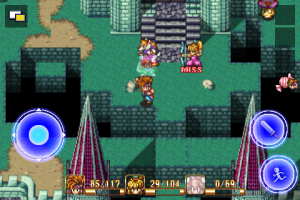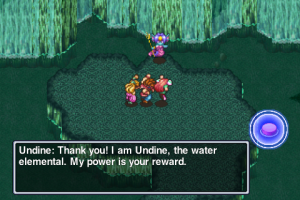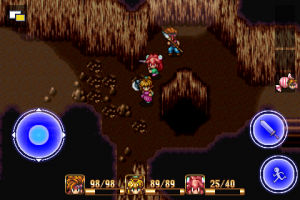Hard to believe it’s already been 17 years since SNES gamers were first captivated by Secret of Mana (Out Now, $8.99). If you’re unfamiliar with this great granddaddy of Action RPGs, here’s the lowdown in a nutshell: young spiky-haired Randi goes from average backwater village teen to heroic outcast the moment he throws the world out of balance by plucking a magical sword from a stone outside his hometown. Never one to leave his errors uncorrected, Randi embarks on a worldwide tour to restore order. Luckily he won’t have to save the world all on his lonesome; during his travels he finds comrades-in-arms in elf princess Primm and a midget Sprite named Popoi.
While the most recent iOS Action RPGs have made attempts at fully fleshed out narratives, Secret of Mana tends toward minimalistic storytelling for better or worse. The unyielding focus here is clearly on gameplay and a sense of grand adventure. Thankfully newcomers to the Mana franchise won’t need nostalgia glasses to see what the big deal was, and still is: Secret of Mana remains a rarity in allowing the player to control an entire party of characters in realtime, switching among them on-the-fly to take advantage of each hero’s unique abilities. The characters not under player control at any given moment act according to behavior assignments the player sets up ahead of time; they can be instructed to support the player, attack enemies the player currently isn’t targeting, etc.
 Combat in Secret of Mana will be an acquired taste for iOS gamers used to combo-heavy action. Combos with repeated button presses are technically possible in this game but they’re beside the point more often than not. Each character expends his or her strength meter by attacking, and additional blows delivered before it charges back up are disappointingly puny. On the other hand, the player can also hold the attack virtual button and charge up for more powerful strikes, Mega Man style. The combat system thus lends itself to opportunistic strikes and requires that the player become deeply familiar with each enemy’s complex behavior. Particularly aggressive foes will make short work of the player’s AI-controlled companions unless they’re instructed to hang back and support the player.
Combat in Secret of Mana will be an acquired taste for iOS gamers used to combo-heavy action. Combos with repeated button presses are technically possible in this game but they’re beside the point more often than not. Each character expends his or her strength meter by attacking, and additional blows delivered before it charges back up are disappointingly puny. On the other hand, the player can also hold the attack virtual button and charge up for more powerful strikes, Mega Man style. The combat system thus lends itself to opportunistic strikes and requires that the player become deeply familiar with each enemy’s complex behavior. Particularly aggressive foes will make short work of the player’s AI-controlled companions unless they’re instructed to hang back and support the player.
Randi, Primm and Popoi draw from the same variety of weapons but the player might find advantages in having each character specialize in two or three sharp implements: the more a character uses a particular weapon, the more special attacks he or she can learn for that weapon over time. Game design ensures that the player will use each weapon type occasionally, as they bear properties useful for clearing specific environmental hurdles.
 While Randi finds himself limited to physical attacks, Primm and Popoi gather the expected array of spells. These are summoned from a ring menu that can be activated several ways in the iOS port – more on that in a bit – and both player and enemy spells are accompanied by a pause in the action that’s liable to be a bit discomfiting for genre veterans used to everything happening on-the-fly. This makes boss battles a curious mix of dependence on player skill and the kind of potion-chugging slugfests we’ve seen on this platform before. The general rule of thumb the player lives by in Secret of Mana is to rely on skill to evade physical attacks but keep those restoratives handy for unavoidable enemy magic.
While Randi finds himself limited to physical attacks, Primm and Popoi gather the expected array of spells. These are summoned from a ring menu that can be activated several ways in the iOS port – more on that in a bit – and both player and enemy spells are accompanied by a pause in the action that’s liable to be a bit discomfiting for genre veterans used to everything happening on-the-fly. This makes boss battles a curious mix of dependence on player skill and the kind of potion-chugging slugfests we’ve seen on this platform before. The general rule of thumb the player lives by in Secret of Mana is to rely on skill to evade physical attacks but keep those restoratives handy for unavoidable enemy magic.
As expected on the iOS, curative items can be hotlinked to small virtual buttons that lay to one side of the touchscreen. There’s one catch in Secret of Mana: these hotlinks are now character-specific, so if Randi or a companion gets knocked out the player loses access to any hotlinked items associated with that character. Spell shortcuts function the same way.
While the character-specific item hotlinks provide an interesting twist on a genre staple, it’s clear Secret of Mana‘s iOS port failed to incorporate other mainstays that the wider genre has developed. In particular, the quest lists and area minimaps Korean Action RPG developers have so painstakingly churned out are completely absent here, so the player is left to his or her own memory and sense of direction for navigating Randi’s world. Repeatable NPC dialogues provide bare minimum reminders of where to go next after setting the game down for an extended period, but I must admit I ended up swallowing my pride and consulting FAQs for the SNES version once or twice. Something weird happened to the average gamer’s life between 1993 and now; whether it’s just the busy nature of people drawn to mobile gaming or a developed addiction to this genre’s ubiquitous quest lists, it’s robbed some of us of our short-term game memories. More than one player will unfortunately reach a point where he or she is left wondering what to do next in Secret of Mana unless it’s played in a few very long sittings.



